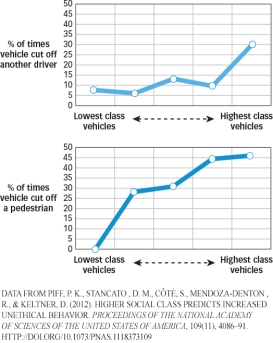Use the following to answer questions :
Scenario I
Scenario I is based on and presents data from the following study (reproduced from p.26 of the textbook) :
Piff,P.K. ,Stancato,D.M. ,Côté,S. ,Mendoza-Denton,R. ,& Keltner,D.(2012) .Higher social class predicts increased unethical behaviour.PNAS Proceedings of the National Academy of Sciences of the United States of America,109(11) ,4086-4091.doi:10.1073/pnas.1118373109
Piff and colleagues (2012) used naturalistic observation techniques to determine if wealthy people behaved more or less ethically than people who were not wealthy.In one study,observers stood at a busy intersection and recorded the make,model,and year of each approaching car.They also noted if the car cut off other cars or pedestrians at this intersection.
Major findings of Piff et al.(2012) are presented in Figure 1.1.This figure shows the percentage of times vehicles cut off another driver (top panel) or pedestrians (lower panel) as a function of the social status of the vehicles (with more expensive cars ranked higher in social status) .
Figure 1.1 
-(Scenario I) A psychologist believes that people in higher and lower social classes learn norms that then affect their behaviour in many different settings.One such norm is that people in higher social classes tend to view themselves as more important than others.As such,the psychologist is not surprised that people driving expensive cars are more likely to disregard the rights of others.This _____ psychologist would predict that _____.
Definitions:
Groupthink
A psychological phenomenon that occurs within a group of people in which the desire for harmony or conformity in the group results in an irrational or dysfunctional decision-making outcome.
Outside Opinion
Perspectives or advice coming from individuals not directly involved in a situation or issue.
Pressure To Conform
The social influence that encourages individuals to match their attitudes, beliefs, or behaviors to group norms.
Groupthink
A phenomenon in social gatherings where the quest for accord or conformity fosters the development of decisions that are unsound or maladaptive.
Q9: It has been observed that the creation
Q47: Words such as "tree," "water skiing," and
Q56: The problem-solving pitfall of a mental set
Q57: Research has revealed that the most effective
Q59: George Sperling attempted to assess the duration
Q74: With regard to the serial position effect,the
Q77: _ assist people in dealing with work
Q86: Within psychology,psychoanalysis had its greatest influence on:<br>A)cognitive
Q109: Most clinical psychologists today work:<br>A)as consultants for
Q124: The confirmation bias can lead to this